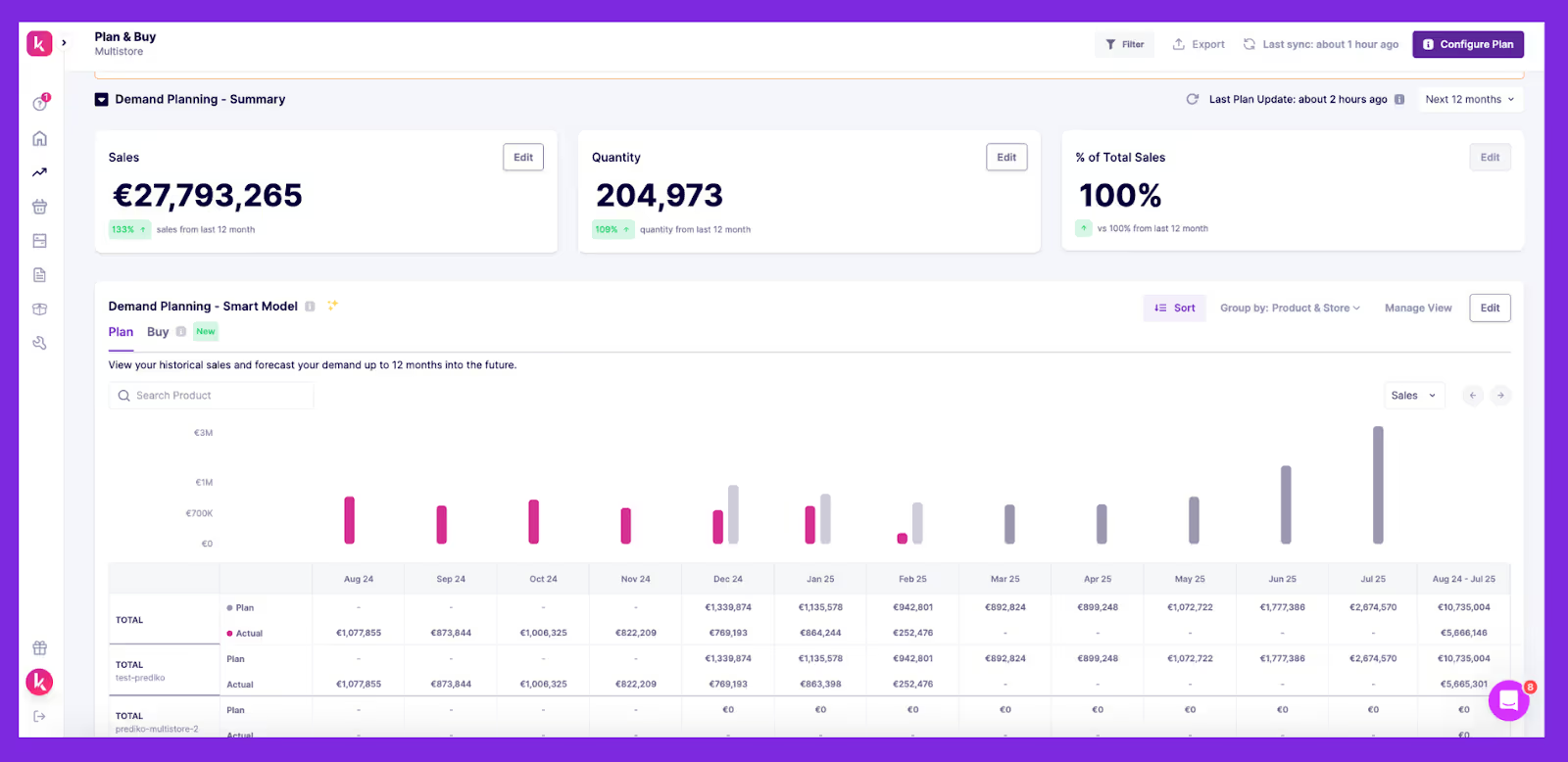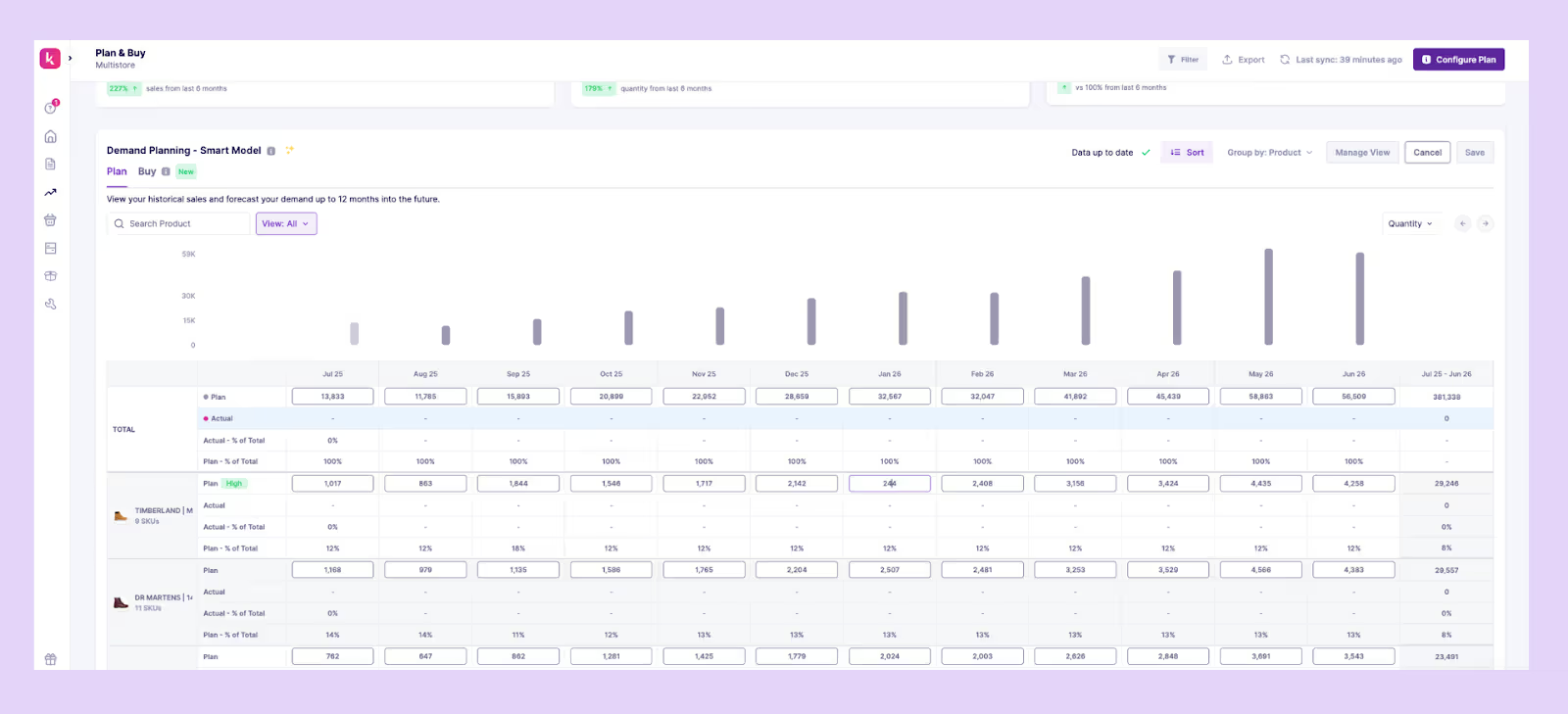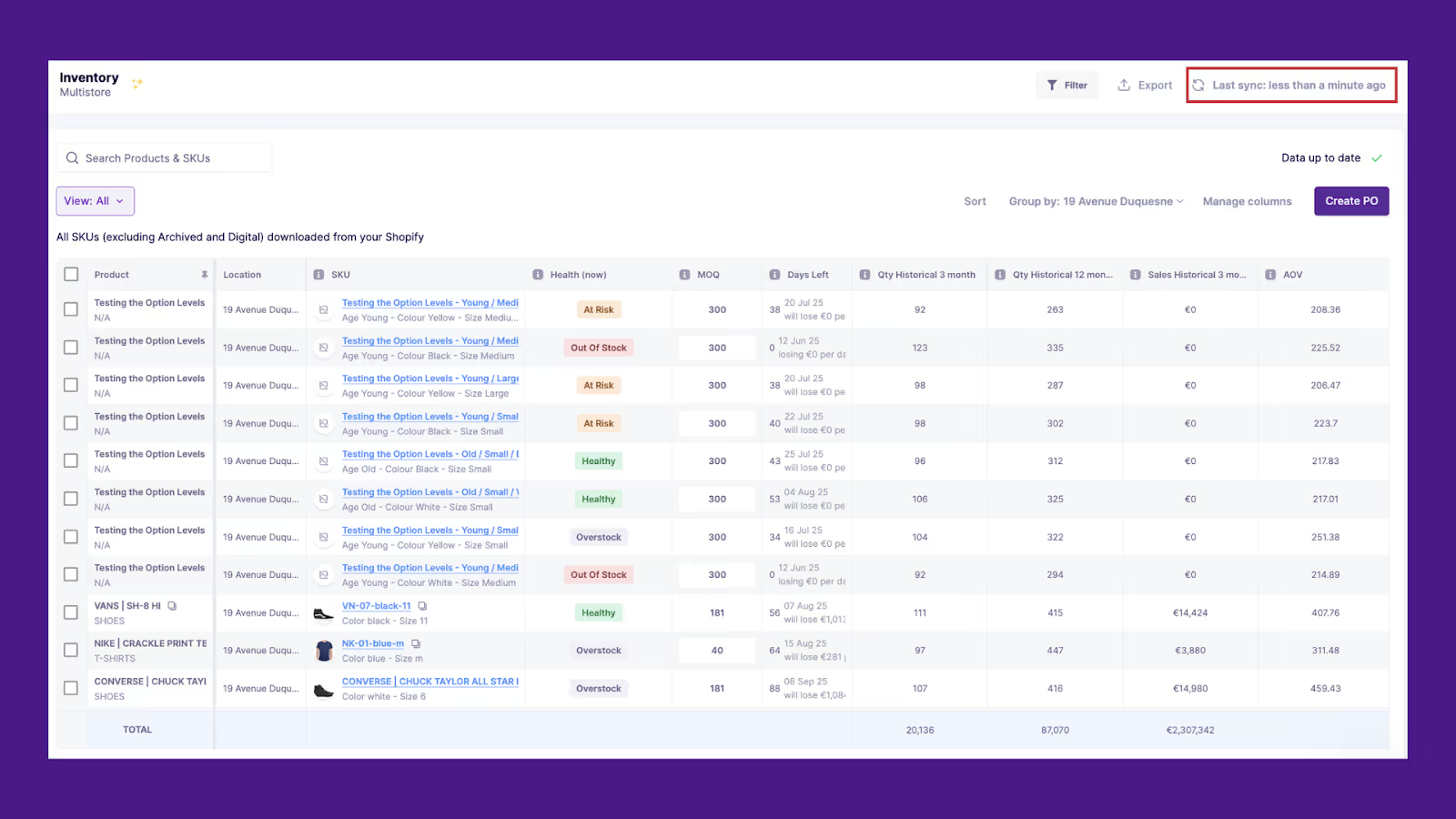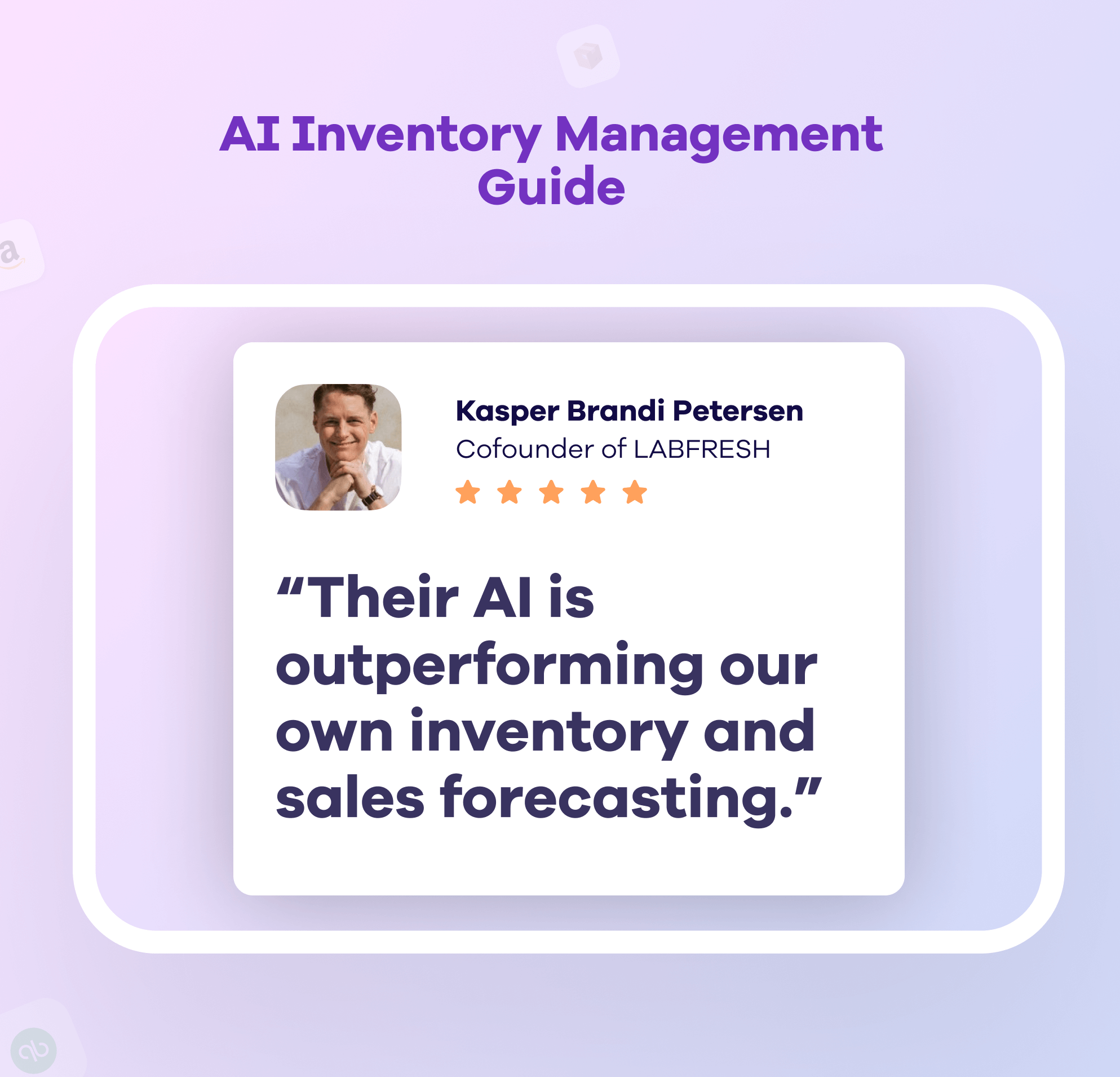Everything’s exciting when you’re launching a new product: nailing the design, teasing the drop, and building hype with your audience.
But then comes the hard part: figuring out how much inventory to order.
New product demand forecasting is tough. There’s no sales history, no trends to follow, and a lot riding on that first inventory order.
Get it wrong, and you risk piling up unsold stock or missing out on early demand.
We’ll walk through why demand forecasting for new products is so tricky, and more importantly, how to do it better with the right approach, data, and tools.
Why New Product Demand Forecasting is Challenging
Forecasting demand for new products isn’t like working with existing SKUs. There’s no past data, no trend lines, and no certainty.
Here’s a deeper look at what makes it harder.
1. No historical data to rely on
Established products come with trends, past sales, and seasonal insights. New products come with none of that.
You don’t have a clear idea of how demand will behave, when to reorder, or how quickly the product will sell. So every estimate ends up being a guess based on assumptions, not real data.
This creates a high-risk environment where you might overestimate and end up tying up cash in unsold stock or underestimate and deal with stockouts, lost sales, and frustrated customers
In this situation, demand signals like pre-orders, competitor product launches, or even social traction become crucial.
2. High risk of over- or understocking
Without past demand data, you end up relying on assumptions when placing your first purchase orders.
If you overestimate, you’ll end up with excess stock that takes up space and ties up working capital. That usually means markdowns or long holding periods.
If you underestimate, you won’t meet initial demand, which leads to missed sales and delays while you rush to restock.
This balancing act is one of the biggest challenges in new product demand forecasting. You don’t get clear demand signals until after launch, and by then, wrong decisions have already cost you time and money.
3. Cannibalization and portfolio effects
New products don’t always create new demand. Sometimes, they just shift demand from your existing products.
This makes forecasting harder. You’re not just estimating how much the new item will sell; you also have to factor in how it impacts the rest of your catalog.
- Will it cannibalize sales from similar products?
- Will it confuse customers and split demand?
Overlooking these effects can inflate forecasts, lead to overproduction, and throw your entire inventory mix off balance.
4. Rapid shifts in trends or competition
Social media trends, influencer endorsements, or a competitor’s move can instantly change what people want.
A competing brand might launch a similar product earlier, offer a lower price, or dominate distribution channels before you get traction.
These shifts are unpredictable and can make your forecast irrelevant in just a few days. They don’t just impact sales, they disrupt timing, channel planning, and overall launch.
5. Limited pre-launch customer signals
One of the toughest parts of new product demand forecasting is doing it without real customer input.
If you haven’t run pre-launch surveys, tested prototypes, or gathered feedback through soft launches or waitlists, you’re off to a weak start.
This creates a blind spot around who will actually buy, how much they’ll want, and what channels they’ll come through.
You can’t identify early traction, validate your pricing, or understand how demand might vary by region or customer segment.
As a result, your initial forecast becomes a high-stakes guess, one that can easily miss the mark and lead to overproduction or missed sales.
Demand Forecasting Methods For New Products
There are different ways to forecast demand for new products. But not all of them are suitable for every situation.
Here are the methods that actually work in practice.
1. Analogy-based forecasting
Analogy-based forecasting uses the performance of a similar product as a reference point.
If you’ve launched something comparable in the past, same category, similar price, same target customer, you use that product’s launch data to estimate demand for the new one.
It’s useful when you’re releasing a line extension or entering a category with clear benchmarks.
This method gives you an anchor when there’s no direct history. It works best if
- You’ve launched something similar before
- You have access to detailed launch data
- The market context hasn’t changed too much
The forecast is only as accurate as the analogy you choose. If the reference product is off, the numbers will be too.
2. Delphi method
This method relies on people who’ve worked on similar launches, from sales, product, marketing, or outside the company. Each person shares their forecast independently.
Next, these forecasts are collected, shared anonymously, and refined over multiple rounds until there’s a clear consensus.
It works well when internal teams have direct insight into customer behavior or category dynamics.
Best suited for
- Early-stage products with limited demand signals
- Companies with strong in-house expertise
- When there’s no past data to rely on and the market is unfamiliar
The accuracy depends on how relevant the experts’ past experience is to the new product.
3. Market testing
This method involves releasing the product in a limited setting before a full-scale launch. It could be through select stores, regions, or a specific online channel.
The goal is to collect real purchase data and customer feedback to guide the forecast.
You can easily test different price points, messaging, or packaging to see what drives demand.
This is suitable when
- You have time to run a test before full production
- The product isn’t seasonal or time-sensitive
- You can replicate test conditions in the broader market
The results are only useful if the test audience matches your target market. If the test is too narrow or the context changes, the forecast may not scale accurately.
4. Customer survey & intent analysis
This method uses direct input from potential customers before launch. You ask how likely they are to buy, what they’d pay, or how they’d use the product. You can run surveys, interviews, or a pre-launch landing page with sign-up prompts.

Works best if
- You target the right customer segment
- You pair surveys with behavioral tests like pre-orders or waitlists
- You need fast feedback during product development
On its own, this method is directional. It’s stronger when combined with actions like pre-orders that show real commitment.
Want to set up pre-orders for your Shopify store? Check out this step-by-step guide.
5. AI/ML models
AI and machine learning models analyze historical sales, product attributes, real-time customer behavior, and past launches to predict demand.
For new products, they identify patterns from similar SKUs or customer segments to build a forecast.
As new data (like early sales) comes in, these models adjust quickly, helping correct early assumptions in real time.
Best for
- Brands with clean historical data across products and channels
- Frequent product launches that need scalable forecasting
- Teams that want real-time, self-adjusting forecasts
Prediko combines historical data, seasonality, and sales velocity to generate dynamic AI-powered forecasts. It updates numbers automatically as new data flows in, so your forecast isn’t static; it evolves with real-time demand.

Step-by-Step Process to Do Demand Forecasting for New Products
You can’t forecast new product demand using a single method or data point.
It takes a structured, step-by-step approach to cut through the guesswork and build a forecast you can actually act on.
Here’s how to do it right.
Step 1: Identify comparable products
Look for products that share key traits with the one you’re about to launch, same price range, customer segment, use case, and channel.
The goal isn’t to find an exact match. It’s to find products that faced similar market conditions at launch.
This could be a previous product you released or one from a competitor with publicly available data.
Look for these key data points in your comparable products.
- Sales patterns in the first 30, 60, 90 days
- Seasonality or timing of the launch
- Marketing or channel strategy used
- How actual demand compared to initial expectations
This step gives you a solid reference point and helps ground the next steps in real data.
Step 2: Conduct market research
Once you have a baseline from comparable products, the next step is to understand the broader market. This includes the total addressable market, current category size, and how much share you can realistically capture.
Start by quantifying the size of the market you’re entering. Look at industry reports, sales data from similar products, or third-party retail data.
Then estimate what portion of that market is reachable based on your price point, positioning, and distribution plan.
Key questions to answer
- What’s the size of the market in your target region or channel?
- Who currently owns the market share?
- Is the category growing, flat, or declining?
This step keeps your forecast realistic by anchoring it to actual market demand. It also reveals how competitive the space is and what’s already driving results.
Step 3: Choose your forecasting approach
Select the method that fits the product and the data you have. The choice depends on how familiar the category is, what internal knowledge exists, and whether early demand signals are available.
If you’ve launched similar products before, analogy-based forecasting gives you a base to work from. For completely new categories, expert judgement can help build directional estimates.
Soft launches provide actual purchase data, and AI/ML models work well when you already have reliable historical data across products.
The method needs to match the kind of product you're launching and how much uncertainty you can afford.
Step 4: Adjust for external factors
No forecast is complete without factoring in what’s happening outside the business. Demand doesn’t exist in isolation, it’s shaped by seasonality, economic shifts, competitor launches, and even promotions running in the same window.
- Look at the timing. Is the product launching during a peak sales period or a slow one?
- Check for competitor activity. Are similar products entering the market at the same time?
- Factor in price sensitivity. What are comparable products priced at? How does your pricing stack up?
These adjustments won’t make the forecast perfect, but they’ll make it realistic. Ignoring external context is one of the quickest ways to derail your forecast.
Step 5: Build multiple variations
With new products, there’s too much uncertainty to work off a single forecast. One number won’t cover the range of possible outcomes.
Create at least three versions: a base case, a high case, and a low case. Each should reflect different assumptions around sell-through, customer response, and availability.
This gives your team clear boundaries to work within and helps identify where the biggest risks or gaps might be. It also forces you to stress-test decisions against different demand levels before you commit to production.
Prediko allows you to edit AI-powered forecasts and see how your supply plan aligns with different inputs. This makes it easier to model scenarios and plan accordingly.

Step 6: Monitor early signals and refine in real-time
The first few weeks after launch tell you more than any pre-launch model can. Track how the product is performing, not just by total sales, but by channel, region, and customer segment.
Look for patterns
- Are sell-through rates matching expectations?
- Which channels are moving faster or slower?
- Are repeat purchases happening, or is it all first-time buys?
Update the forecast based on this data. Don’t wait for a full sales cycle; early adjustments help avoid overstocking or stockouts.

Prediko simplifies this by adjusting reorder alerts in real time based on actual demand. Teams can react faster and avoid tying up cash in excess inventory or running out of stock.
Common Mistakes to Avoid in Demand Forecasting of New Products
Even experienced teams slip up when doing new product sales forecasting. Avoid these common missteps to keep your numbers realistic.
1. Relying only on gut feeling or assumptions
It’s tempting to use instinct or team opinions when forecasting a new product, especially without historical data. But assumptions alone don’t cut it.
A forecast based on what “feels right” often overlooks real-world factors.
You might expect strong sales based on product appeal, but if you're launching in an off-season or during a low-demand period, the numbers won't match.
Without factoring in timing, market conditions, or how similar products performed, assumption-based forecasts tend to fall apart quickly.
2. Ignoring lead times and reorder cadence
Forecasting sales is only half the equation; you also need a clear supply plan to meet that demand.
New products often come with uncertain lead times, especially if you're working with unfamiliar or new suppliers.
P.S. Learn how to manage and deal with suppliers in this guide.
If your forecast assumes steady availability without factoring in production or shipping times, stockouts are likely. You also need to define how often reorders will happen. Without that, it’s hard to match supply to actual demand patterns.
Prediko connects your demand forecast with your supply plan, sending smart alerts on what to reorder, how much, and when, so you always stay ahead of demand.

3. Poor data foundation
A forecast is only as strong as the data behind it. With new products, that often means relying on proxy data, past launches, market research, or early customer feedback. But if those inputs are weak or misaligned, the forecast breaks before it starts.
Common issues include using outdated sales data, pulling comparables from the wrong product category, or relying on survey responses that don’t reflect your actual buyer segment.
Even missing context, like whether sales were promo-driven, can skew your numbers.
Prediko pulls real-time sales and inventory data from your Shopify stores and POS to give you a solid baseline. It also builds a launch plan based on similar product performance, so you're not forecasting in the dark.

4. Overcomplicating the forecast
It’s easy to go overboard with your forecast, too many variables, too many scenarios, too much time spent fine-tuning models to increase the accuracy.
But in reality, this can lead to analysis paralysis, where too much data creates confusion instead of clarity, leading to slow decisions and unclear handoffs between teams.
So, instead of aiming for a perfect forecast, aim for a practical one.
Start with a simple, comparable-based model and iterate as you gather real-world data in th first few weeks. Keep your approach simple, focused, and adaptable.
Prediko simplifies this by focusing only on the inputs that matter, like SKU-level sales velocity, lead times, and real-time stock levels. It keeps the forecast actionable so teams can move quickly without getting stuck in analysis.
5. Sticking rigidly to the initial forecast
First forecast is just a starting point. But many teams treat it as final, even when early sales data or market conditions clearly suggest a shift.
This creates blind spots. stock runs out when demand spikes, or excess inventory piles up when sales slow down. The longer the team sticks to the original numbers, the harder it becomes to adjust operations in real.
A forecast should evolve as new data comes in; sell-through rates, channel performance, and customer behavior must regularly feed back into the model. Without these updates, your forecast quickly drifts from reality.
Best Practices for New Product Demand Forecasting
Forecasting demand for a new product is never exact. But there are best practices to make it smarter, faster, and more grounded.
1. Blend data with expert judgment
Data is essential, but with new products, it’s rarely enough. You’re often working with limited sales history or comparables, so blending what data you have with internal expertise creates a stronger foundation.
Use whatever structured data is available (category performance, similar product launches, seasonality) and then layer in input from your sales, marketing, and product teams.
They can provide insights on expected traction, campaign timing, or early customer feedback that data alone won’t reveal.
This approach balances objectivity and context, improving the accuracy of your early forecasts.
2. Cross-functional alignment
A forecast that isn’t aligned across teams leads to missed orders, overstock, or mismatched expectations post-launch.
Sales, operations, finance, and marketing all rely on the forecast, but they often work with different numbers or assumptions.
That creates friction later when stock doesn’t match demand or budgets are built on unrealistic volumes.
Align early. Involve key teams from the start so everyone understands the forecast, the hypothesis behind it, and the risks involved.
Use a single, shared version across planning, purchasing, and reporting. Avoid scattered sheets or disconnected tools.
Prediko makes this easier by bringing inventory, purchasing, finance, and other teams onto one platform. With a shared, real-time dataset, everyone stays aligned, reducing miscommunication and keeping plans on track.
3. Use “Forecast Range” when communicating
New product forecasts are inherently uncertain. A single number gives a false sense of certainty. Instead, communicate in ranges: best-case, worst-case, and most likely scenarios.
This gives your teams room to plan inventory and cash flow more flexibly and sets more realistic expectations with leadership.
For example, instead of forecasting 5,000 units sold in the first month, you might forecast a range of 4,000-6,000.
That allows your operations team to prepare buffer stock without overcommitting and your finance team to model different revenue outcomes.
Launch with Confidence with Accurate New Product Demand Forecasting
Demand forecasting for new products is tough. There’s no past data, signals are unstable, and the risk of getting it wrong is high.
But with the right methods, tools, and best practices, you can get close enough to make confident decisions. The guide walks you through how to forecast new product demand accurately and practically.
Prediko simplifies this process. It creates a launch plan by analyzing comparable products and builds a connected supply plan, so you know both what to expect and what to order.
You can take it further by generating purchase orders directly from the platform. Inside Prediko, everything’s connected, so from forecasting demand to placing POs, it handles the entire launch workflow in one place.
Start a free 14-day trial and see how Prediko can help build the forecast of your next product launch.
Frequently Asked Questions
How do you forecast the demand for a new product?
Use a mix of comparable product data, market research, expert input, and early customer signals to build a structured estimate.
Which forecasting method is best for new product launches?
It depends on the product and data available, but analogy-based forecasting, expert judgment, and market testing are most commonly used.
What is demand estimation for a new product?
It’s the process of predicting how much a new product will sell over a given period, before launch, based on available inputs.
What are the four methods of demand forecasting?
Four methods of demand forecasting for existing products include qualitative, quantitative, AI/ML, and graphical. However, analogy-based forecasting, expert judgment (Delphi method), market testing, and AI/ML models are commonly used for new products.
.svg)





.png)

